How to Help Clients Training for a Track Meet (Free Guide)
Learning to train clients for a track meet can bring a new dimension to your personal training services. However, it’s crucial to have the right tools and knowledge to effectively assist these clients. Certain features of personal training software can be of great assistance in this task. Discover how to guide clients training for a track meet and the tools you’ll need in this comprehensive guide.
- Assisting clients in track meet training requires an approach that combines speed and endurance workouts, strength and conditioning exercises, and technique improvement drills.
- Most track meet training clients will need a systematic training plan that progressively enhances their speed, strength, and endurance, while also incorporating recovery and flexibility exercises to avoid injuries.
- The use of workout and assessment software can help in tracking progress, scheduling workouts, and managing recovery, ensuring your clients reach their track meet goals safely and effectively.
Guiding clients towards their track meet goals can offer personal trainers a rewarding opportunity to make a significant impact on their clients’ fitness journeys.
To help clients training for a track meet effectively, it’s vital to not only understand the specifics of track and field training but also to have the right tools to monitor progress and adjust training plans; this is where personal training software comes into play. By leveraging the features offered by the best online personal training software, you can guide clients in their track meet training in a way that maximizes their performance and minimizes injury risk.
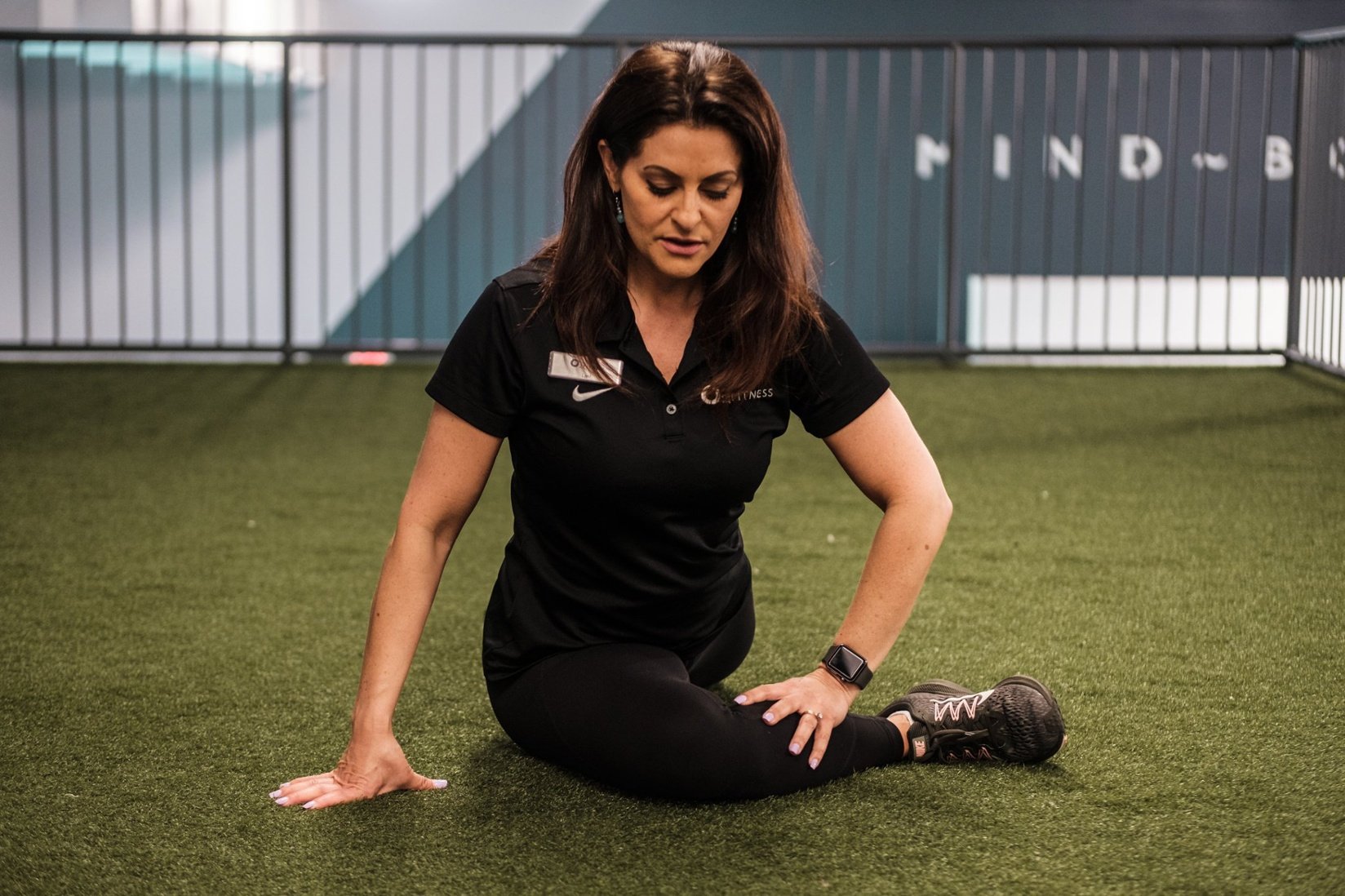
Experience the leading personal training software from Exercise.com by booking a demo today!
The Importance of Proper Training for Track Meets
Track meets are competitive events that require athletes to perform at their best. Whether your clients are beginners or experienced runners, it is essential to provide them with proper training to maximize their performance and help them achieve their goals. In this article, we will discuss the importance of proper training for track meets and provide detailed strategies to help your clients excel in their events.
Proper training is crucial for track meet success. It not only enhances an athlete’s physical abilities but also builds mental resilience. Training for track meets enables athletes to improve their endurance, speed, agility, and overall performance. Without a well-designed training plan, athletes may struggle to reach their full potential and risk injuries. Therefore, as a trainer, it is your responsibility to guide your clients through a comprehensive training program that covers various aspects of track meet preparation.
One key aspect of proper training for track meets is the incorporation of strength and conditioning exercises. These exercises help athletes develop the necessary muscle strength and power to excel in their events. Strength training exercises such as squats, deadlifts, and bench presses can improve an athlete’s explosive power and overall performance. Additionally, conditioning exercises like interval training and sprints can enhance an athlete’s cardiovascular fitness, allowing them to sustain high-intensity efforts throughout their races.
In addition to physical training, mental preparation is also essential for track meet success. Athletes need to develop mental resilience and focus to overcome challenges and perform at their best. Techniques such as visualization, positive self-talk, and goal setting can help athletes stay motivated and maintain a competitive mindset. Mental training can also help athletes manage pre-race nerves and perform under pressure, ultimately improving their overall performance in track meets.
Read More:
- How to Help Clients Training for a Trail Race
- How to Help Clients Training for a Triathlon
- How to Help Clients Training for a 5K
- How to Help Clients Training for a Marathon
Setting Clear Goals for Track Meet Training
Before starting any training program, it is important for athletes to establish clear and achievable goals. By defining goals, athletes have a target to aim for during their training and can stay motivated. Goals should be specific, measurable, attainable, relevant, and time-bound (SMART). Encourage your clients to identify their desired track meet performance outcomes and break them down into smaller, manageable milestones. This approach allows athletes to track their progress and make necessary adjustments to their training plan along the way.
One important aspect of setting clear goals for track meet training is to ensure that they are realistic and attainable. It is crucial for athletes to set goals that are within their capabilities and align with their current fitness level. Setting unrealistic goals can lead to frustration and demotivation. By setting attainable goals, athletes can maintain a positive mindset and work towards continuous improvement.
In addition to setting performance goals, it is also beneficial for athletes to establish process goals. Process goals focus on the actions and behaviors that athletes need to take in order to achieve their desired outcomes. These goals can include things like maintaining a consistent training schedule, improving technique, or implementing proper nutrition and recovery strategies. By setting process goals, athletes can stay focused on the steps they need to take to reach their performance goals.
Designing a Personalized Training Plan
Every athlete has unique strengths, weaknesses, and training requirements. Therefore, it is essential to design a personalized training plan for each client. Consider their current fitness level, previous training experience, and specific track meet events they will be participating in. Focus on a balanced approach that includes cardiovascular exercises, strength training, speed drills, and flexibility exercises. A well-rounded training plan will help athletes develop the necessary skills and fitness levels required for their chosen events.
When designing a personalized training plan, it is important to take into account the athlete’s individual goals and aspirations. Some athletes may be aiming to improve their overall performance, while others may have specific targets such as breaking a personal record or qualifying for a major competition. By understanding their goals, you can tailor the training plan to meet their specific needs and help them achieve their desired outcomes.
In addition to considering the athlete’s goals, it is also crucial to regularly assess and adjust the training plan as needed. As athletes progress and their fitness levels improve, it is important to modify the plan to continue challenging them and promoting further development. Regular evaluations and adjustments will ensure that the training plan remains effective and aligned with the athlete’s evolving needs and capabilities.
The Role of Nutrition in Track Meet Preparation
Nutrition plays a critical role in an athlete’s performance and recovery. Encourage your clients to follow a well-balanced diet that provides the necessary nutrients to fuel their training sessions and optimize their body’s performance. Emphasize the importance of consuming an adequate amount of carbohydrates for energy, lean proteins for muscle repair, and healthy fats for overall well-being. Additionally, educate your clients about the importance of hydration and the benefits of incorporating pre- and post-training snacks into their routine.
One key aspect of nutrition in track meet preparation is timing. It is important for athletes to consume their meals and snacks at the right times to maximize their performance. Encourage your clients to eat a balanced meal containing carbohydrates, proteins, and fats about 2-3 hours before their training or competition. This will give their bodies enough time to digest and absorb the nutrients, providing them with sustained energy throughout their event.
Another important consideration is the quality of the food athletes consume. While it is crucial to meet their macronutrient needs, it is equally important to focus on the quality of the food sources. Encourage your clients to choose whole, unprocessed foods whenever possible, as these provide a greater variety of micronutrients and antioxidants that can support their overall health and recovery. Encourage them to include plenty of fruits, vegetables, whole grains, and lean proteins in their diet.
Building Endurance and Stamina for Track Meet Success
Endurance and stamina are crucial for any track meet event, whether it be sprints, middle-distance, or long-distance races. Help your clients develop their endurance by incorporating longer runs, interval training, and tempo runs into their training regimen. Gradually increase the distance or duration of their workouts over time to challenge their aerobic capacity and improve their stamina. Encourage regular evaluation of their progress to ensure they are continually pushing their boundaries and improving their overall endurance levels.
Enhancing Speed and Agility for Track Meets
Speed and agility are key factors in various track meet events such as sprints, hurdles, and relays. To help your clients enhance their speed, incorporate specific speed workouts into their training plan. These can include interval training, hill sprints, and plyometric exercises. Additionally, focusing on agility drills, such as ladder exercises or cone drills, can improve their quickness and maneuverability on the track. By incorporating both speed and agility training, athletes can gain a competitive edge in their respective events.
Incorporating Interval Training into Track Meet Workouts
Interval training is an effective method to improve both aerobic and anaerobic fitness levels. By alternating between high-intensity and rest intervals during training, athletes can push their limits and increase their overall performance. Encourage your clients to include interval training sessions in their workouts. This can be achieved through various methods, such as track repeats, fartlek training, or interval circuits. Adapt the intensity and duration of these workouts based on your clients’ capabilities and goals.
Strengthening Core Muscles for Improved Performance
A strong core is essential for maintaining proper posture, stability, and power during track meet events. Incorporate exercises that target the core muscles, such as planks, Russian twists, and medicine ball throws, into the training plan. Strong core muscles contribute to improved technique, increased power output, and reduced risk of injury. Regularly assess and progress the difficulty of these exercises to continuously challenge your clients and help them develop a solid core foundation.
Strategies for Preventing Injuries during Track Meet Training
Injury prevention is paramount when training for track meets. Athletes pushing their limits can be susceptible to various injuries. Educate your clients about the importance of warming up properly before each training session, incorporating dynamic stretches, and cool down effectively. Additionally, emphasize the importance of listening to their bodies, recognizing early signs of fatigue, and avoiding overtraining. Encourage cross-training and rest days to allow their bodies to recover and prevent the risk of overuse injuries.
Mental Preparation Techniques for Track Meets
Mental preparation is just as important as physical training when it comes to track meets. Help your clients develop mental strategies to stay focused, confident, and positive. Techniques like visualization, goal-setting, positive self-talk, and relaxation exercises can greatly enhance their mental resilience. Encourage athletes to practice these techniques during training and incorporate them into their pre-competition routines. Building mental strength and resilience will help your clients handle the pressures and challenges they may face during track meet events.
Fine-Tuning Technique and Form for Track Meet Events
Proper technique and form are essential for optimal performance in track meet events. Analyze your clients’ running mechanics and provide feedback to help them make necessary adjustments. Focus on stride length, arm swing, foot strike, and overall posture. Incorporate drills and exercises that target specific technical elements of their chosen events. Continuous refinement of technique will help your clients maximize efficiency, reduce energy wastage, and ultimately improve their overall performance.
Utilizing Cross-Training to Improve Track Meet Performance
Cross-training is an effective way to enhance overall fitness and prevent training plateaus. Encourage your clients to incorporate activities such as swimming, cycling, or strength training into their training plan. These activities provide variety, work different muscle groups, and challenge the body in different ways. Cross-training not only helps prevent overuse injuries but also improves overall athleticism and adds an element of fun to the training routine.
Tracking Progress and Adjusting Training as Needed
Maintaining track of progress is crucial during training. Monitor your clients’ performance regularly through timed trials, distance covered, or technical assessments. Documenting progress helps both the trainer and the athlete identify areas of improvement and make informed adjustments to the training plan. Based on the feedback and data collected, modify the intensity, duration, or type of exercises to keep the program challenging and aligned with each client’s goals.
Preparing for Different Weather Conditions at Track Meets
Track meet events can take place in various weather conditions, including heat, cold, rain, or wind. Train your clients to be adaptable by simulating different weather conditions during their training. Encourage them to practice running in different temperatures, protective clothing, and proper hydration strategies. Provide tips on pre-race warm-ups and cooling strategies specific to different weather conditions. By preparing for various scenarios, athletes can perform well regardless of weather challenges.
Motivational Tips to Keep Clients Focused on their Goals
Motivation is vital in helping your clients stay dedicated to their track meet training. Keep them inspired by regularly sharing success stories of athletes, both professional and amateur. Provide positive reinforcement and celebrate small achievements along the way. Encourage them to participate in group training sessions or connect with fellow athletes to foster a sense of camaraderie and support. Remind them of their long-term goals and guide them through any motivational slumps they may encounter.
Handling Pre-Race Nerves and Anxiety at Track Meets
Pre-race nerves and anxiety are common among athletes participating in track meets. Teach your clients relaxation techniques such as deep breathing, progressive muscle relaxation, or guided imagery to manage their pre-race anxiety. Help them develop pre-race routines that include warm-up drills, visualization, and positive self-talk. Remind them that nervousness is normal and can even enhance performance if managed properly. By equipping your clients with coping strategies, they can face the start line with confidence and composure.
Recovering Properly after a Track Meet Event
Proper recovery is essential for muscle repair and overall performance improvement. Educate your clients about the importance of post-event recovery practices such as gentle cool-down exercises, stretching, and adequate rest. Encourage them to fuel their bodies with a combination of carbohydrates and proteins to replenish glycogen stores and facilitate muscle repair. Incorporate recovery days into their training plan to allow their bodies to rest and rejuvenate before resuming intense training.
This comprehensive guide has covered multiple aspects of helping clients train for a track meet successfully. By implementing these strategies and personalizing them to fit your clients’ specific needs, you can greatly enhance their performance, minimize the risk of injuries, and help them achieve their track meet goals.
Remember, each athlete is unique, and flexibility in your training approach will allow you to cater to their individual aspirations and capabilities. By providing personalized guidance and support, you can empower your clients to reach their full athletic potential and experience success in their track meet events.
How do you train someone for track?
Training someone for track involves a combination of speed, endurance, and strength training specific to track events. It includes a mix of interval training, sprint workouts, tempo runs, and longer distance runs to develop speed, stamina, and aerobic capacity. Additionally, incorporating strength training exercises that target the muscles used in track events, such as squats, lunges, plyometrics, and core exercises, can enhance power, explosiveness, and overall performance.
How do you train for track events?
Training for track events involves a systematic approach tailored to the specific event. It includes a combination of speed workouts, interval training, technique drills, and event-specific training sessions. For sprint events, short and intense interval training is crucial, while longer distances may require more focus on endurance and pacing. Practicing event-specific skills, such as relay exchanges, hurdling techniques, or throwing techniques, is also important for success in track events.
How do beginners prepare for track?
Beginners preparing for track should start with a gradual training program that includes a mix of running, stretching, and strength exercises. It’s important to focus on building a foundation of endurance and gradually increasing training intensity and volume. Incorporating drills to improve running form and technique, such as strides, skips, and high knees, can also be beneficial. Working with a coach or joining a track club can provide guidance and structure for beginners to progress effectively.
How do you practice the day before a track meet?
The day before a track meet, it’s important to focus on rest, recovery, and light activity. This may include a short jog or gentle dynamic stretches to warm up the muscles. It’s essential to stay hydrated, eat a balanced diet, and get a good night’s sleep. Mental preparation is also key, visualizing successful performances and reviewing race strategies. However, it’s important to avoid intense workouts or activities that could cause fatigue or muscle soreness before the competition.
How do you mentally prepare for a track meet?
Mental preparation for a track meet involves developing a positive mindset, confidence, and focus. Strategies include visualizing successful performances, setting realistic goals, and using positive self-talk. Developing pre-race routines, such as listening to music or engaging in calming activities, can help reduce anxiety and improve focus. Working with a sports psychologist or mental skills coach can provide additional guidance and techniques to enhance mental preparation for track meets.
How can you make track practice fun?
Making track practice fun can involve incorporating variety, teamwork, and friendly competitions. It’s important to include drills and exercises that challenge athletes while keeping them engaged and motivated. Mixing up training locations, implementing relay races or obstacle courses, and organizing team challenges can add an element of excitement to practice sessions. Additionally, providing positive reinforcement, creating a supportive team environment, and recognizing individual and team achievements can contribute to a fun and enjoyable track practice experience.
How do you lift and train for track?
Strength training for track involves exercises that target the muscles used in track events, such as the legs, core, and upper body. It includes exercises like squats, lunges, deadlifts, plyometrics, and Olympic lifts to develop power, explosiveness, and muscular strength. It’s important to focus on proper form and technique and gradually increase the weight and intensity of the exercises. Working with a strength and conditioning coach or a certified personal trainer can ensure a safe and effective strength training program tailored to track training needs.
How do you prepare for a track team?
Preparing for a track team involves a combination of physical training, mental preparation, and team bonding. It’s important to follow a structured training program that includes endurance, speed, and strength workouts specific to track events. Mental preparation involves setting goals, developing race strategies, and visualizing successful performances. Building team camaraderie through team activities, encouraging mutual support, and fostering a positive team culture can enhance preparation for a track team.
How do you train for an endurance event?
Training for an endurance event, such as a long-distance track race, requires a focus on building aerobic capacity and endurance. It involves incorporating longer distance runs, tempo runs, and interval training to improve stamina and pacing. Gradually increasing training volume, incorporating recovery days, and practicing nutrition and hydration strategies are important aspects of endurance event training. Additionally, mental preparation, race simulation, and goal setting are crucial for success in endurance events.
What not to do before a track meet?
Before a track meet, it’s important to avoid overexertion or doing anything that may cause excessive fatigue or injury. It’s best to avoid intense or new workouts that could lead to muscle soreness or fatigue on the day of the competition. Trying new foods or unfamiliar supplements is not recommended to prevent digestive issues. Lastly, it’s important to manage stress and get adequate rest to ensure optimal physical and mental readiness for the track meet.
How can a beginner train for track?
Beginners training for track should start with a gradual approach, focusing on building a foundation of endurance and gradually increasing training intensity and volume. Incorporating a mix of running workouts, such as easy runs, intervals, and tempo runs, can improve overall fitness. It’s important to incorporate rest days for recovery and to prevent overuse injuries. Consulting with a coach or joining a track club can provide guidance and structure for beginners to develop their skills and progress effectively.
What exercises do you do to train for track?
Exercises for track training include a combination of running workouts, strength training, and drills to improve technique and performance. Running exercises may include interval training, tempo runs, hill sprints, or long-distance runs, depending on the event. Strength training exercises can include squats, lunges, plyometrics, and core exercises to enhance power and explosiveness. Technique drills like high knees, skipping, or strides can improve running form and efficiency. The specific exercises depend on the track event and individual training needs. Consulting with a track coach or certified personal trainer can provide personalized exercise recommendations for track training.
Use the Best Personal Training Software to Offer a Stellar Client Experience
Training clients for a track requires a comprehensive and tailored approach. See how Exercise.com can help.

To learn more about how Exercise.com can help you run your fitness business, book a demo now!
Creating Training Plans for Clients Who Want to Compete in Track
Here’s how you can help your clients accomplish their goals by using workout plan creator software to create workout plans, run fitness challenges, offer online workout groups, message clients, and more, all from your very own custom branded fitness apps.
Exercise.com stands out as an all-in-one fitness business management software with comprehensive workout plan sales capabilities. The robust member management, billing & invoicing, and unique fitness assessment tools offer a one-stop solution for fitness business needs. Here’s just some of what you can do with the Exercise.com platform:
Engage with clients via automations.
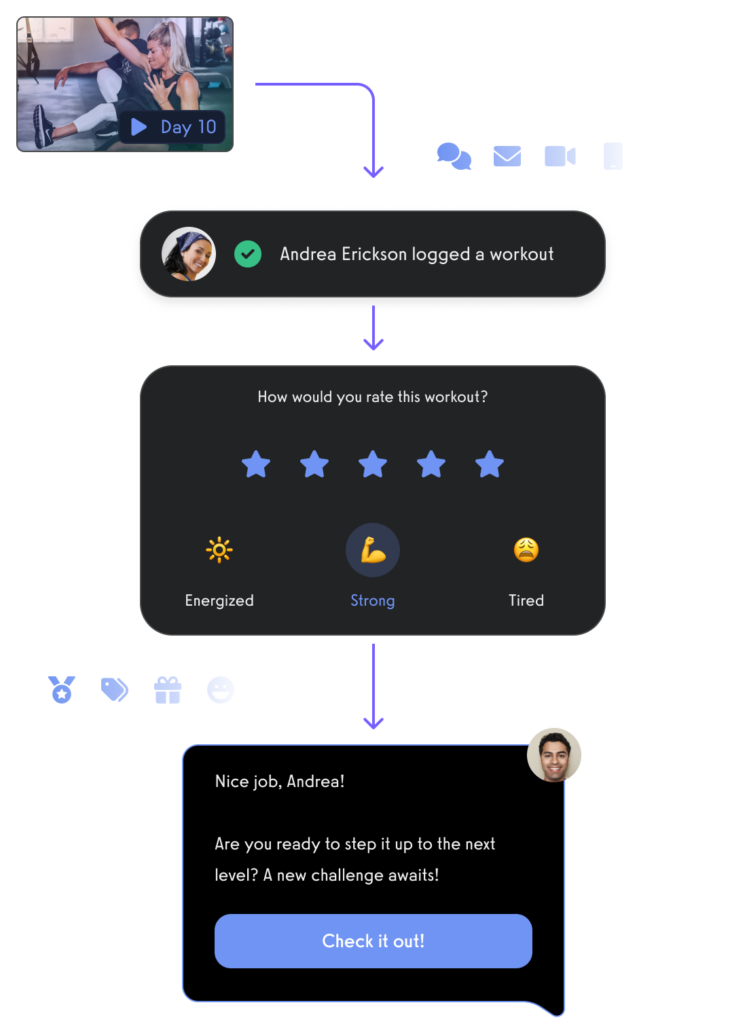
Manage leads with a fitness CRM. Read More: Best CRM Software for Gyms
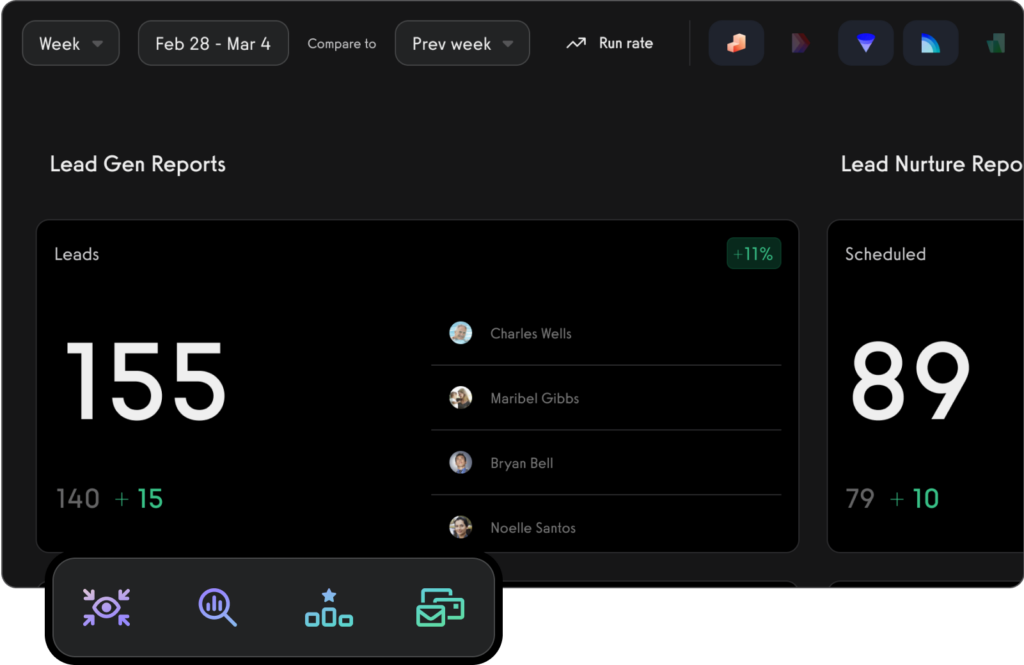
Create and send fitness assessments with ease.
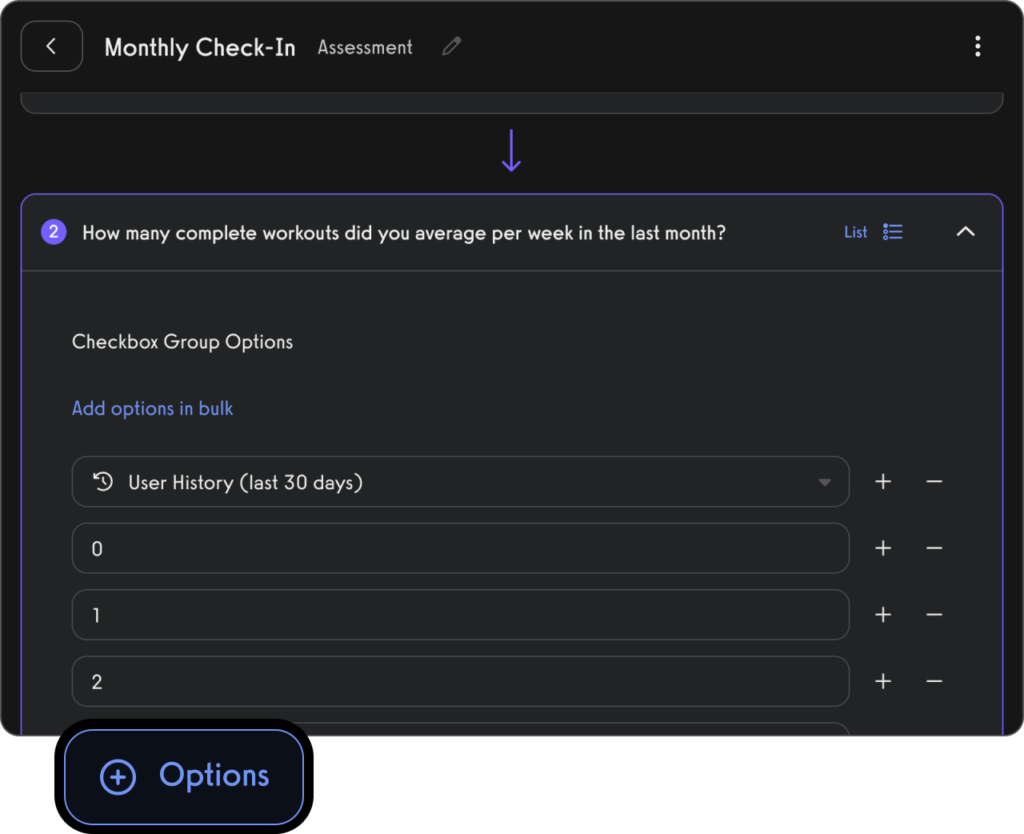
Use fitness habit tracking to inspire and motivate personal training clients (in-person and remote).

Use fitness progress photos to engage with clients.
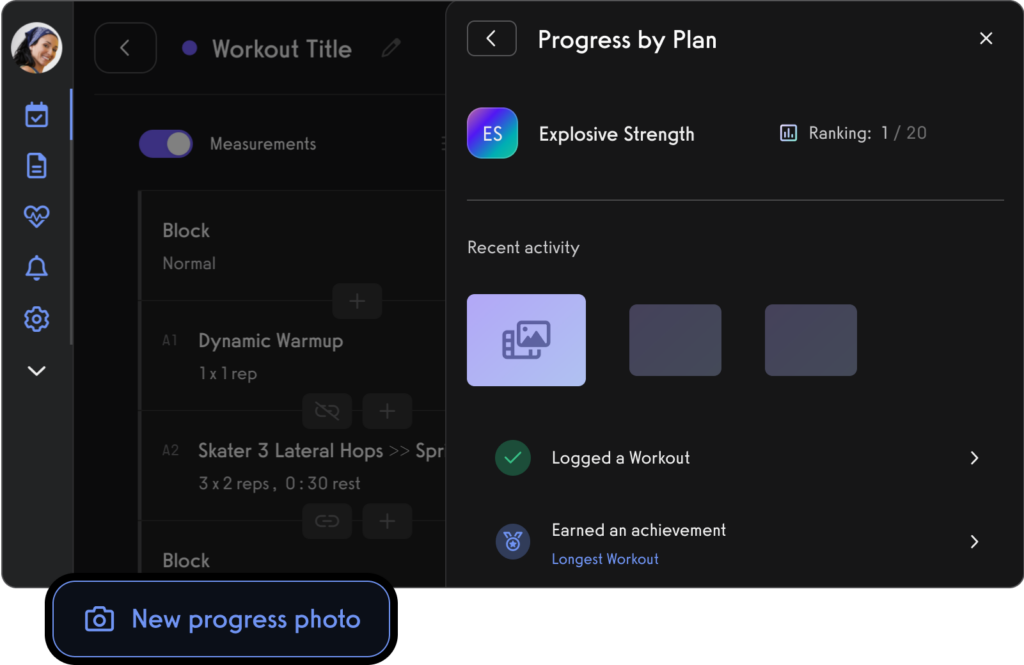
Use fitness leaderboards to track performance and inspire healthy competition.
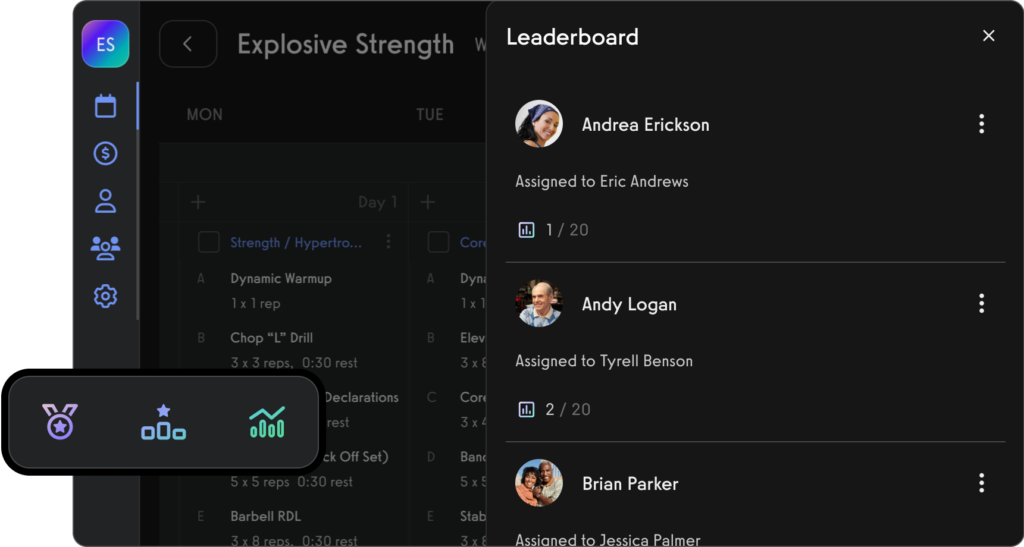
Use the exercise demonstration video library or create your own custom exercise demonstration videos.

Create workout plans for parents and dependents, teams and more.

Manage personal training clients with ease.

Book appointments for clients (Read More: Best Gym Booking Software)

Create classes and fitness groups

Manage fitness challenges (Read More: 100+ Fitness Challenge Ideas)
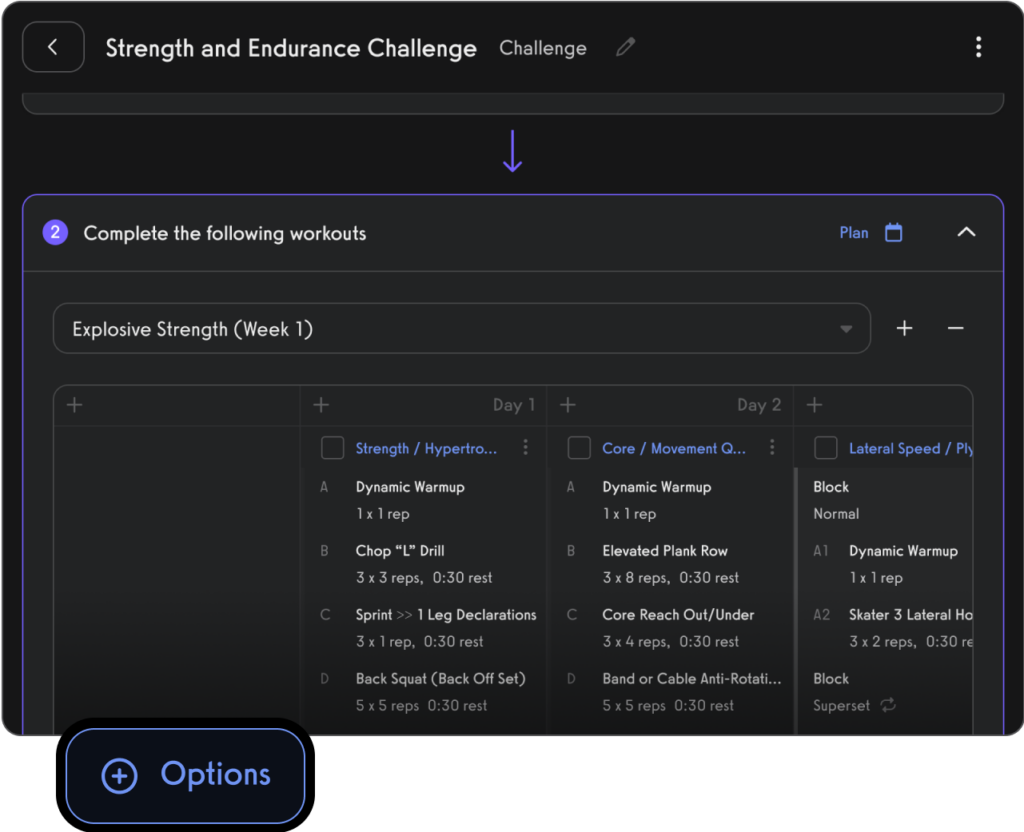
Process payments for open gym, classes, and personal training.

Communicate with gym members, athletes, team members, personal training clients, class members, parents, and dependents via SMS, email, and in-app push notification.
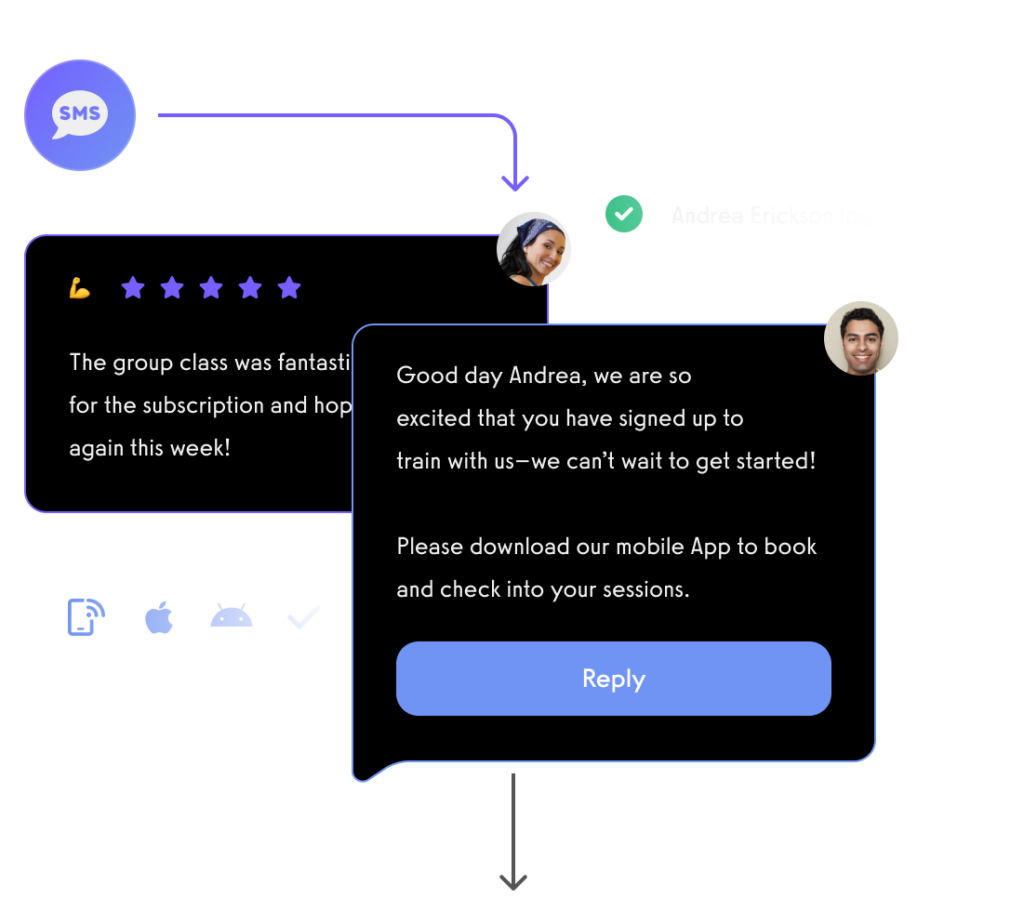
View performance over time, track personal records, and other fitness stats with performance reporting dashboards.
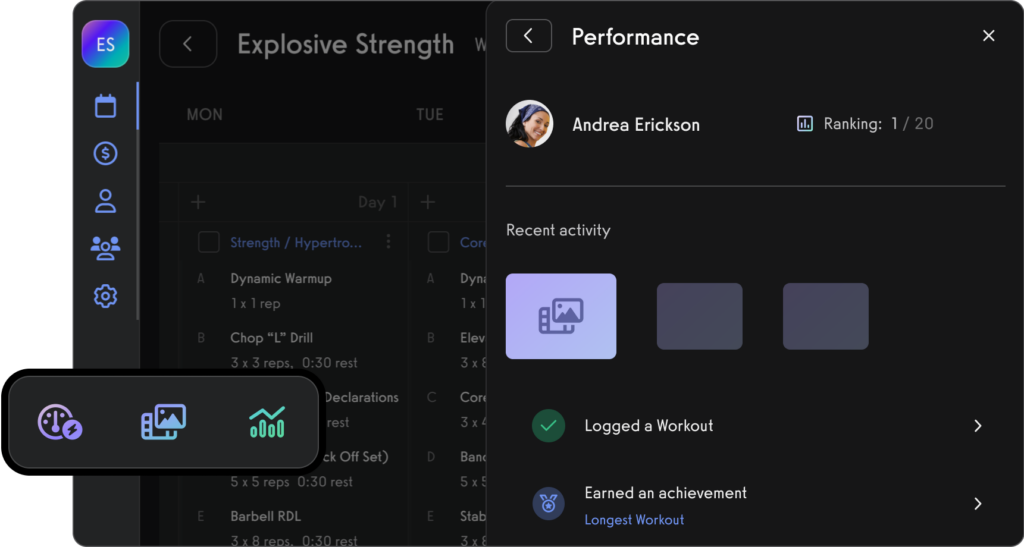
And of course, view all of your fitness business reports easily too.
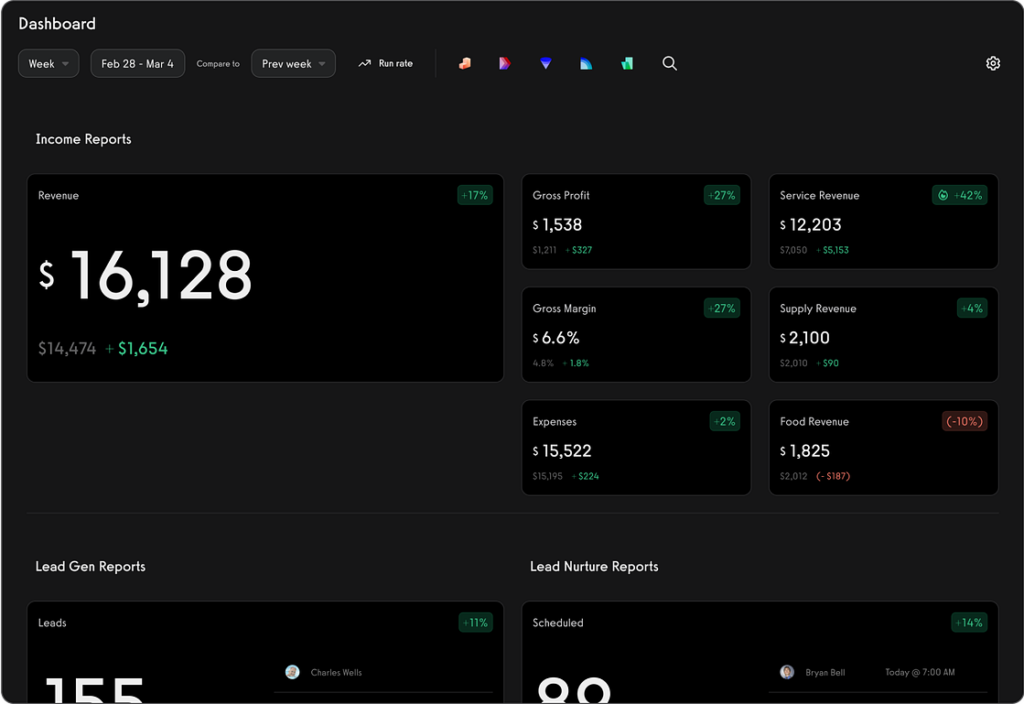
All from your custom-branded fitness apps (Read More: Best Gym Mobile Fitness Apps Software)

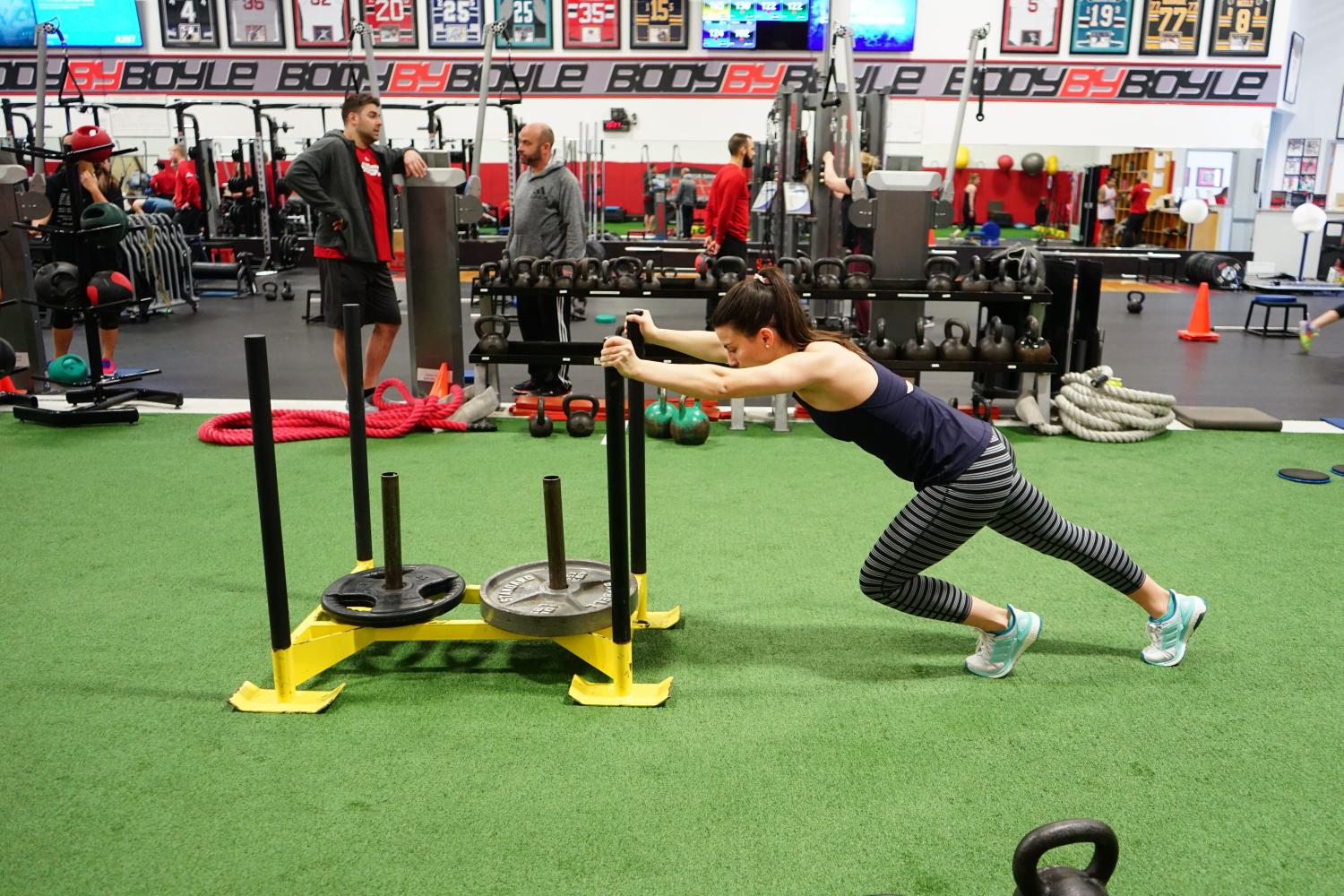
Want to learn how your fitness business can take it to the next level? Get a demo now!









